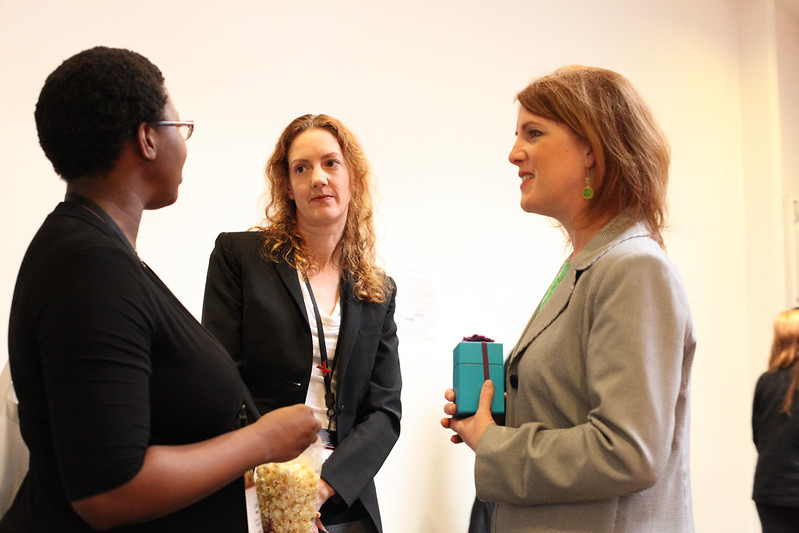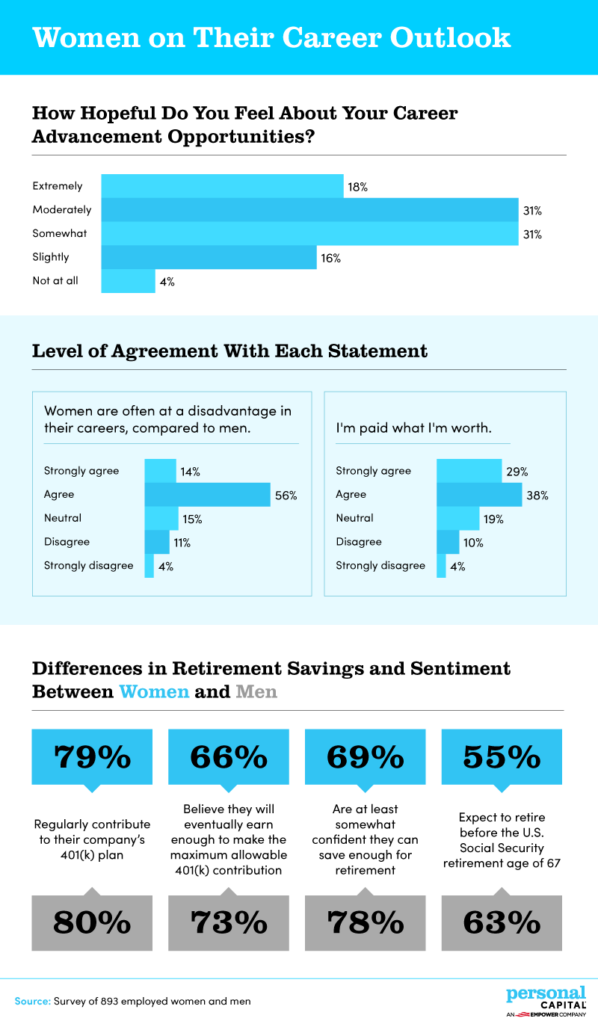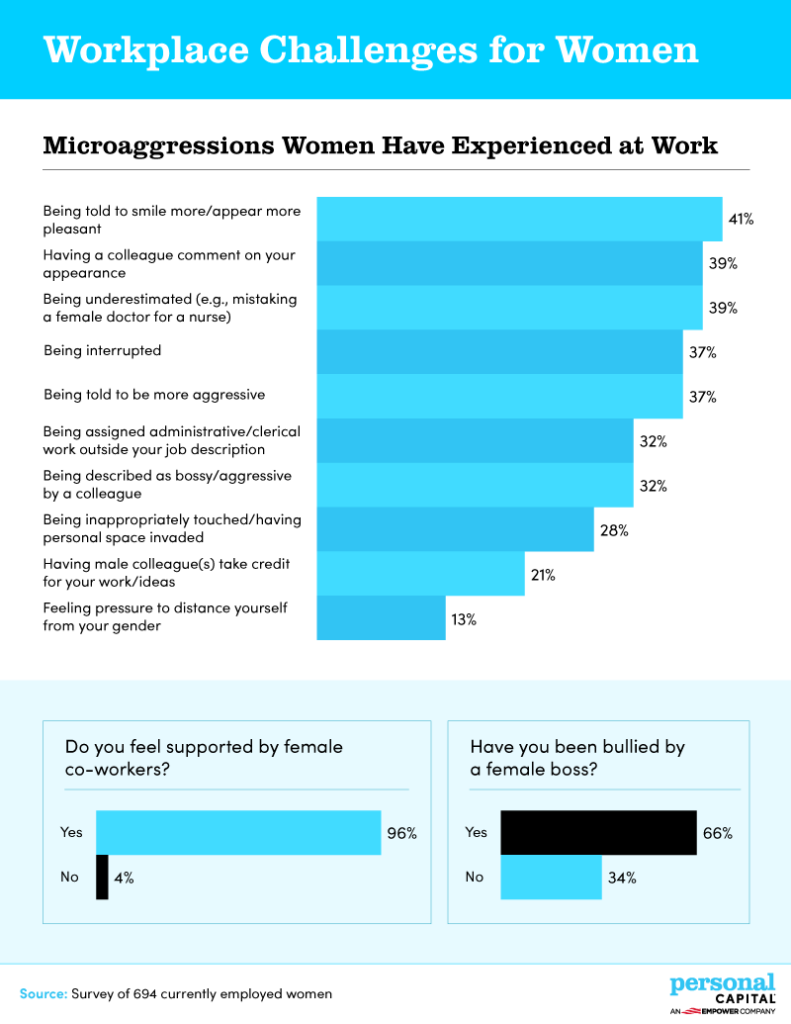In the last few months, a shocking number of women have been forced out of the work force. Data shows that even when women keep their jobs, they face different obstacles than their male colleagues.

While women have advanced in the work force in recent history, there is still a great deal that needs to be done to further this equality to men. Still, women are paid 82 cents for every dollar that a man makes—and for Black women, Indigenous women and Latinas, this number drops to 62 cents, 60 cents and 55 cents, respectively. In the last few months, a shocking number of women have been forced out of the work force.
Now, new data shows that even when women keep their jobs, they face different obstacles than their male colleagues.
In a new study, financial adviser Personal Capital surveyed nearly 900 people—more than 100 of whom were female entrepreneurs—about their experiences and the hardships women face in the workforce. Workplace benefits by gender were also analyzed to see just what the differences were.
Some initial findings:
- 45 percent of women have addressed the gender pay gap at work. Over 9 in 10 of them experienced retaliation for it.
- About two in three women report asking for and being denied a promotion or raise during their career. The median age for women receiving their first promotion to a management role is older than it is for men (28 vs. 25).
- Men and women participate in perks programs at similar rates, but men have access to these programs more than women (85 percent vs. 75 percent).
- 28 percent of women surveyed had been entrepreneurs for less than a year. About half these women said they became entrepreneurs as a result of the COVID-19 pandemic.
Read on to learn more.
Women on Their Career Outlook
According to the study, only 18 percent of women were extremely hopeful about their career advancement opportunities. Nearly two in three women were moderately or somewhat hopeful. But 16 percent were just slightly optimistic that they would earn a promotion, and four percent had no hope at all.
Female respondents were asked whether they felt at a disadvantage in their careers compared to men, and seven in 10 women reported that they either agreed or strongly agreed with that statement. Just 15 percent disagreed or strongly disagreed with the sentiment. But when asked if they felt like they were paid what they were worth, more than two-thirds (67 percent) assented.

Retirement for men and women was analyzed, and the report showed men were more likely to have the opportunity to save money. Slightly more men (80 percent) reported regularly contributing to their 401(k) plan than women (79 percent), and men were seven percentage points more likely to believe they would eventually earn enough to make the maximum contribution to their 401(k).
The most significant difference between men and women was that men were nine percentage points more likely to feel at least somewhat confident that they would be able to save enough money for retirement. And 63 percent of men expected to retire before the Social Security age of 67, compared to just 55 percent of women.
Workplace Challenges for Women
How old were women when they earned their first promotion, compared to men? According to the survey, the median age for women earning their first promotion to a management role was 28 years old, while a man’s first promotion tended to happen at age 25. Women also revealed that their last promotion or raise was in the past 12 months. Roughly two-thirds of women reported asking for and being denied a raise or promotion at some point in their careers.

Another challenge that women face while at work are microaggressions. The most common experiences women faced were being told to smile more or appear more pleasant (41 percent), having a colleague comment on their appearance, and being underestimated (39 percent apiece).
More than one in three women were interrupted frequently or were told to be more aggressive. One-third of women were given clerical or administrative tasks outside of their regular duties and more than one in five women also had men take credit for their work or ideas.
While most (96 percent) women felt supported by their female co-workers, 66 percent reported feeling bullied by female bosses.

Women on Pay Equity
Nearly half (45 percent) of women said they addressed the gender pay gap at work, and of those women, 91 percent reported feeling retaliated against because of it.
For women who did not bring attention to this issue, 52 percent said it was because they did not want to put their career advancement opportunities at risk, while nearly half (46 percent) reported fearing retaliation.
Approximately two in five women either did not have concrete proof of the inequity or did not think that saying something would make a difference. Also, 13 percent were discouraged from saying anything by their friends, family, or co-workers.
The study also reviewed the difference between men and women in regards to benefits. While men and women participated in benefits programs at similar rates, men reported having increased access to these programs more often than women when they became available.
Experiences of Female Entrepreneurs
Nearly three in four women business owners reported feeling satisfied with their careers even though most of these respondents said they only made $35,000 or less annually. About 62 percent of these women said they opened their business because they wanted to, not because they needed to.
More than one in four women entrepreneurs said they had taken this career path within the past year, and half of these women said they made this career change due to the COVID-19 pandemic.
About half (45 percent) of female business owners said they had a professional mentor, most of which were other women.
While women’s workplace opportunities have improved dramatically over the years, there is still much work to be done.
You may also like:





